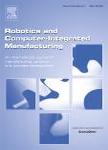版权所有:内蒙古大学图书馆 技术提供:维普资讯• 智图
内蒙古自治区呼和浩特市赛罕区大学西街235号 邮编: 010021

作者机构:CAD Laboratory for Systems/Robotics Department of Electrical and Computer Engineering University of New Mexico Albuquerque NM 87131 United States Robotic Research Laboratory Department of Mechanical Engineering University of New Mexico Albuquerque NM 87131 United States
出 版 物:《ROBOTICS AND COMPUTER-INTEGRATED MANUFACTURING》 (Rob Comput Integr Manuf)
年 卷 期:1989年第6卷第4期
页 面:331-337页
核心收录:
学科分类:12[管理学] 1201[管理学-管理科学与工程(可授管理学、工学学位)] 08[工学] 0802[工学-机械工程] 0811[工学-控制科学与工程] 0812[工学-计算机科学与技术(可授工学、理学学位)]
主 题:Robots, Industrial
摘 要:Control of tool-workpiece interaction force is of vital importance in automated assembly. Using a simple linear continuous model of an edge-following system to predict the appropriate accomodation gains in a force control loop, previous work has shown that force control by accomodation is feasible. Following up this work, this paper describes the analysis, simulation and implementation of an adaptive force control in a two-dimensional edge-following task with a PUMA 560 robot and wrist force sensor. First, a discrete-time model of an edge-following system is developed and then used as the plant; second, a model reference adaptive control (MRAC) scheme is applied to achieve both tracking and regulation purposes. The reference (tracking) model can be determined by experimental reference input and desired model output information; the reference (regulation) model can be obtained by simulation to smooth out the plant output and improve the augmented filtered plant-model error. Study is done on the values of the adaptation gains in the adaptive mechanism, and hence can be adjusted to insure the best plant output performance.